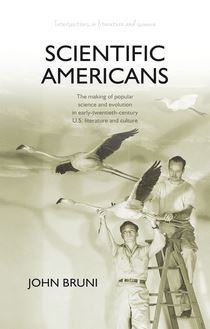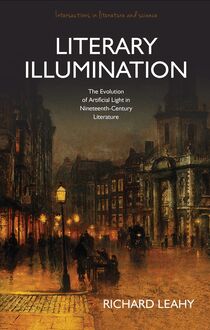Literary Illumination , livre ebook
129
pages
English
Ebooks
2018
Vous pourrez modifier la taille du texte de cet ouvrage
Obtenez un accès à la bibliothèque pour le consulter en ligne En savoir plus
Découvre YouScribe et accède à tout notre catalogue !
Découvre YouScribe et accède à tout notre catalogue !
129
pages
English
Ebooks
2018
Vous pourrez modifier la taille du texte de cet ouvrage
Obtenez un accès à la bibliothèque pour le consulter en ligne En savoir plus
Publié par
Date de parution
15 août 2018
Nombre de lectures
3
EAN13
9781786832702
Langue
English
Literary Illumination examines the relationship between literature and artificial illumination, demonstrating that developments of lighting technology during the nineteenth century definitively altered the treatment of light as symbol, metaphor and textual motif. Correspondingly, the book also engages with the changing nature of darkness, and how the influence of artificial light altered both public perceptions of, and behaviour within, darkness, as well as examining literary chiaroscuros. Within each of four main chapters dedicated to the analysis of a single dominant light source in the long nineteenth-century – firelight, candlelight, gaslight, and electric light – the author considers the phenomenological properties of the light sources, and where their presence would be felt most strongly in the nineteenth century, before collating a corpus of texts for each light source and environment.
Introduction
Chapter One: Firelight
1.1 Nineteenth Century Firelight: Hearth, Home and Industry
1.2 Gaskell, Dickens, Fire and Reverie
1.3 Variable Flames in Urban Domesticity
1.4 Fire and Reverie in Industrial Desperation
Chapter Two: Candlelight
2.1 A Brief History of Candlelight
2.2. Candle Theory and its Symbolic Value in Literature
2.3 The Candle and the Literary Detective
2.4 The Candle and the Gothic Unknown
2.5 The Candle and Ambiguity of Mental States
Chapter Three: Gaslight
3.1 Gaslight in the Nineteenth Century
3.2 The Networked City: Gaslight on Literary Streets
3.3 The Theatre: Gaslight’s Stage
3.4 The Department Store: Gaslight’s Dressing Room
Chapter Four: Electric Light
4.1 Electric Light in the Nineteenth Century
4.2 Jules Verne’s prophetic electric light of the 1860s and 70s
4.3 The Transient Light of H.G. Wells’s Fin-de-Siècle
4.4 Electric Light 1900-1914: Realisation and Realism
Summary and Conclusions
Publié par
Date de parution
15 août 2018
EAN13
9781786832702
Langue
English
LITERARY ILLUMINATION
INTERSECTIONS IN LITERATURE AND SCIENCE
Series Editors
Ruth Robbins, Leeds Beckett University
Susan Watkins, Leeds Beckett University
Editorial Board
Daniel Cordle, Nottingham Trent University
Clare Hanson, University of Southampton
George Levine, Rutgers University
Roger Luckhurst, Birkbeck, University of London
Alan Rauch, University of North Carolina at Charlotte
Simon Schaffer, University of Cambridge
Keir Waddington, Cardiff University
Do we still live in a world of ‘two cultures’, as C. P. Snow so memorably suggested in the late 1950s? Recent literary scholarship suggests that we don’t, though there do continue to be misunderstandings between scientists and humanities practitioners. This series is concerned with the intersections between literary research and scientific and technological advances. It is concerned with the ways in which science as a range of practices and philosophies, and technologies in all their guises, inform literary practice; in how science can also be challenged by literary practices and representations; and in what happens to each of these discourses when they are brought into play with each other. Literature and Science publishes pathfinding research which examines the conjunctions and disjunctions that occur when (possibly) different world views are brought together. It is our mission to bring to readers and scholars at all levels innovative thinking and writing about scientific and literary narratives that concern themselves with the medical humanities, ecocriticism, representations of technology and science fictions.
LITERARY ILLUMINATION
THE EVOLUTION OF ARTIFICIAL LIGHT IN NINETEENTH-CENTURY LITERATURE
Richard Leahy
© Richard Leahy, 2018
All rights reserved. No part of this book may be reproduced in any material form (including photocopying or storing it in any medium by electronic means and whether or not transiently or incidentally to some other use of this publication) without the written permission of the copyright owner. Applications for the copyright owner’s written permission to reproduce any part of this publication should be addressed to the University of Wales Press, University Registry, King Edward VII Avenue, Cardiff CF10 3NS.
www.uwp.co.uk
British Library CIP Data
A catalogue record for this book is available from the British Library.
ISBN: 978-1-78683-268-9
e-ISBN: 978-1-78683-270-2
The right of Richard Leahy to be identified as author of this work has been asserted in accordance with sections 77 and 79 of the Copyright, Designs and Patents Act 1988.
The publisher has no responsibility for the persistence or accuracy of URLs for any external or third-party internet websites referred to in this book, and does not guarantee that any content on such websites is, or will remain, accurate or appropriate.
Cover image: John Atkinson Grimshaw, Blackman Street, London (1885). By permission, The History Collection / Alamy Stock Photo.
Cover: Olwen Fowler
CONTENTS
Introduction: The Nineteenth-Century Lightscape
1 Firelight
1.1 Nineteenth-Century Firelight: Hearth, Home and Industry
1.2 Gaskell, Dickens, Fire and Reverie: The Domestic and the Individual
1.3 Variable Flames in Urban Domesticity
1.4 Fire and Reverie in Industrial Desperation
2 Candlelight
2.1 A Brief History of Candlelight: An Ancient Light in the Nineteenth Century
2.2 Candle Theory and its Symbolic Value in Literature
2.3 The Candle and the Literary Detective
2.4 The Candle and the Gothic Unknown
2.5 The Candle and Ambiguity of Mental States
3 Gaslight
3.1 Gaslight in the Nineteenth Century
3.2 The Networked City: Gaslight on Literary Streets
3.3 The Theatre: Gaslight’s Stage
3.4 The Department Store: Gaslight’s Dressing Room
4 Electric Light
4.1 Electric Light in the Nineteenth Century: Evolution and Revolution
4.2 Jules Verne’s prophetic electric light of the 1860s and 1870s
4.3 The Transient Light of H. G. Wells’s Fin-de-Siècle
4.4 Electric Light 1900–14: Realisation and Realism
Summary and Conclusions
The Lightscape of the Early Twentieth Century: Why Stop Here?
The Key Ideas: Blurring of Archetypes, Modernity and the Individual
Notes
Bibliography
LIST OF ILLUSTRATIONS
Cover image – John Atkinson Grimshaw, ‘Blackman Street, London’, 1885.
FIGURE 1 ‘Ladies by the Fireside’ engraving by George A. Elcock.
FIGURE 2 Illustration of cellar dwelling originally published in The Illustrated London News , 29 November 1862.
FIGURE 3 Illustration from an 1892 chemistry book detailing Michael Faraday’s 1860 lecture on ‘The Chemical History of a Candle’.
FIGURE 4 Illustration of ‘The Pit and the Pendulum’ by Harry Clarke, in Edgar Allan Poe’s Tales of Mystery , 1919.
FIGURE 5 Camille Pissarro, ‘The Boulevard Montmartre at Night’, 1897.
FIGURE 6 Cartoon taken from Punch , 1878, entitled ‘Electric Light Comes’.
FIGURE 7 Jablochkoff candles on Victoria Embankment, 1878.
FIGURE 8 The modern lightscape, 2017 (image author’s own).
INTRODUCTION: THE NINETEENTH-CENTURY LIGHTSCAPE
Light, by its very nature, is oppositional. Its binary relationship with darkness has led to light emerging as one side of a symbolic structure that has become representative of other similarly positive and negative dichotomies. Symbolism within western culture and literature has been dominated by the white and black dualism of light and dark for a very long time. God, in the Book of Genesis, creates light, and emphasizes the human relationship with it: ‘And God saw that the light was good; and God separated the light from darkness.’ 1 Light is clearly contrasted to darkness, as it is set up as a positive symbol; it is ‘good’. It is knowledge, power and understanding ‘separated’ from darkness’s negative obscurity. As Michael Ferber establishes in A Dictionary of Literary Symbols : ‘Light and Darkness are probably the most fundamental and inescapable terms, used literally or metaphorically, in the description of anything in life or literature.’ 2 Through further biblical examples, and references to Dante’s Inferno , Milton’s Paradise Lost , Beowulf and certain Greek myth, he elaborates on the role of light and darkness in literature: ‘Light is traditionally linked with goodness, life, knowledge, truth, fame, and hope, darkness with evil, death, ignorance, falsehood, oblivion and despair.’ 3 Artificial light sits awkwardly in between these states, and in nineteenth-century literature reflected something more complex than just dichotomous opposites.
At the start of the nineteenth century, the symbolic relationship between light and dark was still primarily binary. Lord Byron writes of fear of the absence of light in his 1816 poem, ‘Darkness’, a poem that was published just prior to the boom in artificial light that emerged later in the century. It imagines the ‘dread’ and ‘desolation’ of a world without day:
Morn came and went – and came, and brought no day,
And men forgot their passions in the dread
Of this their desolation; and all hearts
Were chill’d into a selfish prayer for light. 4
The people Byron describes become aware of their desolation in the dark of eternal night. Their prayers for light are ‘selfish’ – the desire they have for light causes them to forget their passions and yearn for any kind of light. Byron writes of a dark apocalyptic wasteland where:
The palaces of crowded kings – the huts,
the habitations of all things which dwell,
were burnt for beacons; cities were consumed,
And men were gather’d round their blazing homes
To look once more into each other’s face. 5
Fire, a man-made source of light, binds the people of Byron’s poem. Artificial light, unlike the absent sun, can be controlled and provide illumination, hope and life in the desperation of Byron’s wasteland. Byron presents this type of artificial light as having its own symbolic potency; it has distinct psychological, social and cultural effects.
Anna-Teresa Tymieniecka describes what she terms ‘The Primeval Dialectic of Life’, in the relationship between light and dark:
When we refer in any way to light and/or darkness, their essential conjunction is necessarily surmised – conjunction and opposition. This very opposition indicates a primal relationship: darkness without reference to light would have no degree in quality, no pitch, no intensity; in fact, it would have no qualitative endowment at all. This amounts to saying that there would be no meaning of ‘darkness.’ And the same holds for light. 6
Tymieniecka suggests that the dialectic of light and dark permeates life itself, and influences consciousness and individual psychology and ideology. There is something satisfying about the binary dualism of light and dark metaphor: it is a clear and attractive prospect to narrative and symbolic satisfaction – it is either one or the other. Greg Lynall argues that ‘in the eighteenth century there is a shorthand of referential meanings’ used by poets and writers to refer to light in a way that suggests ‘light [as] representing rationality, knowledge, understanding’. 7 Yet artificial light, by its very nature, troubles such cadential metaphoric resolution, and begins to suggest states between rigid structures of light as positive and darkness as negative. Through this creation of an alternate space of reality – one that does not conform to the order of day and night, or the natural progression of light to dark, and dark to light – the invention and adoption of artificial light in the nineteenth century had a distinct effect on individual and social psychology. People had greater freedom of movement within towns and cities, and domestic life was constantly changing to suit its new illumination. In his book, At Day’s Close: Night in Times Past , A. Roger Ekirch suggests that artificial illumination is ‘arguably the greatest symbol of modern progress’: ‘By blurring the boundaries between day and night, [it] altered the pace and scope of people’s



